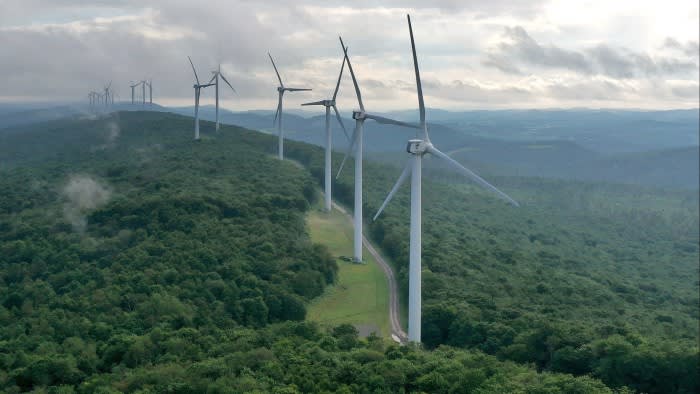Stay informed with free updates
Simply sign up to the Renewable energy myFT Digest — delivered directly to your inbox.
G7 countries are set to agree a global target this weekend to increase electricity storage capacity sixfold from 2022 to 2030, as countries grapple with how to keep the lights on while shifting to intermittent wind and solar power.
Ahead of a two-day meeting starting on Sunday, climate ministers have “agreed in principle” a global goal for electricity storage capacity of 1,500 gigawatts in 2030, up from 230GW in 2022, according to a draft document seen by the Financial Times.
That includes the use of batteries, hydrogen, water or other solutions to store electricity.
There are fraught discussions on several other areas, with coal among the most contentious, along with energy efficiency and methane targets. Japan in particular has pushed back against an ambitious shift away from coal.
The current text, which has not been agreed, says countries should phase out the use of coal power from which emissions are not captured shortly after 2035. Under new rules unveiled by the US on Thursday, coal plants planning to stay open beyond 2039 will have to cut or capture 90 per cent of their carbon dioxide emissions by 2032.
The talks mark the first time G7 energy and climate ministers have met since almost 200 countries agreed at the UN COP28 climate talks in December to “transition away” from fossil fuels. At the meeting in Dubai they also agreed to double energy efficiency and triple renewable energy capacity by 2030.
The burning of fossil fuels is by far the biggest contributor to global warming, but the shift to renewables has raised major questions about energy supplies at times when the wind is not blowing and the sun is not shining.
One official involved in the G7 talks said the energy storage target was a “good” solution and showed that countries were taking the agreement reached in Dubai seriously by focusing on implementation. Energy storage aims to stockpile excess energy when conditions for renewables are optimal, using options such as batteries, then discharge it as necessary.
Hydroelectric dams currently provide the greatest store of renewable energy, but only about 15 per cent of energy is generated by hydropower. The International Energy Agency expects batteries to account for 90 per cent of new storage.
The G7 will “promote stationary battery storage development and deployment to increase storage efficiency and reduce storage costs,” as well as “encourage a diversified, sustainable, secure and transparent supply chain for battery storage”, according to the draft.
The International Energy Agency said this week that the “rapid expansion” of batteries would be critical to meeting the energy goals set at COP28.
It found that growth in batteries outpaced almost all other clean energy technologies in 2023, with 42 gigawatts added to electricity supplies around the world thanks to falling costs, better technology and supportive industrial policies.
Battery costs have fallen by more than 90 per cent over the past 15 years, one of the fastest declines ever seen in clean energy technologies, the IEA said.
In draft language not yet signed off by ministers, the document also proposed backing a push by the world’s richest countries to end subsidies for fossil fuel development abroad, the biggest source of international public finance for the sector.
Ahead of discussions scheduled in June, the US and the EU have differed over the extent of a proposed ban on OECD countries extending export credit agency loans and guarantees for oil, gas and coal mining projects.


